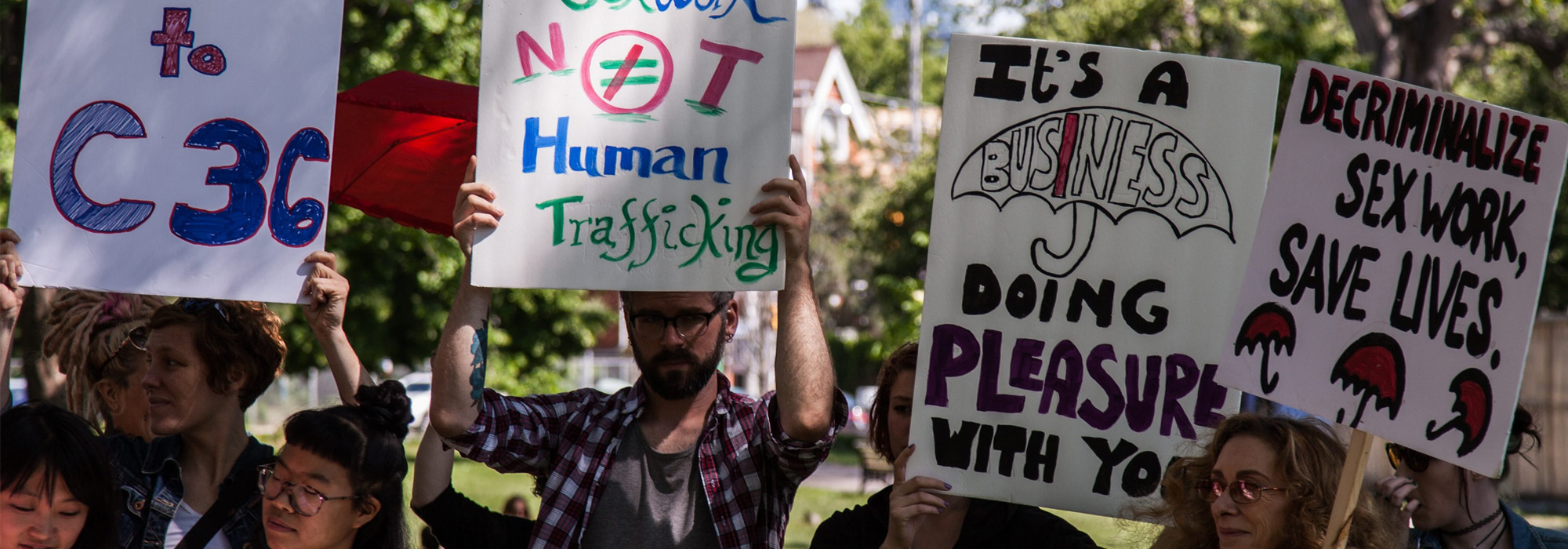
(This article has been translated into French.)
If there was ever a topic within criminal justice that’s been hotly debated, it is prostitution. People may become entrenched in their views because of their ideology regarding sex work. These views can then be mapped onto a continuum of positions and beliefs about prostitution. To the left are those who adhere to an abolitionist stance, while to the far right are those who insist that legalization is the best approach. The main ideological perspective that permeates a society often winds up dictating the provincial governments’ application of federal laws, in the form of policies around the sex trade. This is indeed a challenge, but a workable middle ground is possible if governments and policy-makers are willing to invest in the short- and long-term well-being of all their citizens.
The term “prostitution” is conceptualized as any act that involves the trade of sexual service for money or some other form of payment. While prostitution itself was not illegal in Canada until recently, the Criminal Code prohibited essentially every other activity related to prostitution in public and private spheres. In the 2013 decision R. v. Bedford, the Supreme Court struck down three sections [210, 212(1)(j) and 213(1)(c)] of the Criminal Code, noting that these sections violated section 7 of the Canadian Charter of Rights and Freedoms (which says that everyone has the right to security of the person). As a result, it was no longer considered illegal to keep or be found in a common bawdy house, to live off the avails of prostitution or to communicate in public for the purpose of prostitution. The Court stated:
The prohibitions…do not merely impose conditions on how prostitutes operate. They go a critical step further, by imposing dangerous conditions on prostitution; they prevent people engaged in a risky — but legal — activity from taking steps to protect themselves from the risks.
As Glenn Betteridge and Joanne Csete noted in their 2016 report on sex work, because it was illegal to engage in sex work in a public place (“communicating”) and because it was illegal to be in a brothel or similar establishment (keeping or being found in a common bawdy house), sex workers were forced into the dark alleys and margins of society, where they were easily preyed upon. They were forced into debt servitude (at the hands of pimps and organized crime), because it was illegal for sex workers to earn a living from sex work (“living on the avails”), which was in fact a legal enterprise.
The federal government, under Prime Minister Stephen Harper, tabled legislation (Bill C-36) in 2014 in response to the Supreme Court ruling. Bill C-36, the Protection of Communities and Exploited Persons Act, came into force December 6, 2014. This legislation made the act of purchasing a sexual service from another person illegal. Prostitution in Canada became illegal.
It’s interesting to note that the revised laws no longer use the term prostitution. What the Act did was emulate the “Nordic model,” which views all prostitution as an exploitation of primarily women and girls. The ideology behind this approach is to reduce the occurrence of prostitution by penalizing the purchasers of sex and others who benefit financially from the prostitution of others, such as pimps and organized crime. Although honourable in its intention, the legislation falls short of supporting sex workers or protecting the most vulnerable. Sex workers lose earnings and the ability to support themselves when clients stay away for fear of being arrested. And those most vulnerable, the women and girls exploited and forced underground, do not benefit from the criminalization of clients because their industry of exploitation is already hidden and in the shadows, away from police attention.
The continuum of debate on prostitution reflects a spectrum of ideology and influences. At the far left are the abolitionists, while at the far right are those who favour legalization. In between we have those who support the criminalization of sex work (mid-left) and those who favour decriminalization (mid-right).
Melissa Farley, a clinical psychologist and a researcher in favour of abolition, noted in 2004 that harm (both psychological and physical) and violence are inherent to prostitution, regardless of whether sex work is legal or illegal, decriminalized or regulated. This abolitionist view holds that all sex work is abusive, victimizing and enslaving. The goal of the abolitionists is to eradicate sex work entirely, and in so doing they refuse to accept the personal agency of sex workers.
To criminalize aspects of prostitution is to make it illegal to sell or purchase sex or both. This approach is rooted in the philosophy of abolition, with a moral ethos that buying and selling sex is wrong and deserves punishment. Criminalizing prostitution means that society agrees there is inherent harm in sex work and aims to prevent people from engaging in it by making all related behaviours illegal. However, criminalizing all aspects of it does not address or eradicate its causes.
Canada has partially adopted this approach. Harper’s Bill C-36 embodies the belief that all prostitution is victimization and therefore all aspects deserve to be criminalized. Furthermore, the approach views all sex workers as victims and deserving of protection. Bill C-36 has thus decriminalized their behaviour. All of this is problematic because the Bill remains contradictory: if a law opposes all aspects of prostitution, then it needs to develop an appropriate framework for exactly that purpose.
Decriminalization seeks to find a balance between supporting sex workers (with exit and/or harm reduction programs) and reducing or eliminating exploitation and forced prostitution. Those who advocate for decriminalization argue that criminalizing sex work marginalizes and isolates sex workers and fosters and fuels violence. Making it illegal undermines the ability of sex workers to access justice, to maintain health, to be protected under labour laws and to embrace their sexual autonomy. However, decriminalization does not ensure that buyers of sex are healthy and peaceful either.
Those supporting legalization define sex work as bona fide work and believe it should be subject to provincial and municipal workplace health and safety regulations, health care benefit requirements and conditions of licensing, and that income from it should be taxable. From this perspective, those working in the sex trade are not considered victims or exploited persons. Rather, advocates of legalization believe that sex work is a by-product of societies around the world, and therefore it makes sense to legalize and regulate it. Arguments in favour of legalization include the advantage to governments of earning revenue from business licences and taxes, and a reduction in criminal elements and violence, which would in turn increase health, safety and the agency of men and women. However, legalization would not automatically jettison rapists and murderers, and it would not guarantee that all sex workers would be able to work within the new system (because of mental illness, addiction and/or infections and the like).
The continuum of prostitution encompasses many different points of view; an argument could be made for either end or any point in between. However, what is realistic in contemporary society? Abolition is an idealistic and unrealistic goal despite the parameters of Bill C-36. That’s not because abolition isn’t possible, but because the government (and society) does not wish to make long-term, sustainable investments in the myriad of social programs necessary to tackle the causes of prostitution (poverty, addiction, mental illness, child abuse).
Widespread legalization and regulation are also unrealistic, if for no other reason than the fact that each province has jurisdiction in the administration of justice. With competing ideologies and changing governments, it would be near impossible for every province to adopt and apply the same regulations. Furthermore, legalization would still exclude the most vulnerable. For example, if we were to run a legitimate brothel that required us to pay taxes and ensure the health and safety of our workers, we would want to hire women who have all of their teeth, who do not have a debilitating mental illness, who are addiction-free and who are healthy. In reality, there would still be many women who would not qualify to work in regulated brothels. Where do they go then? The causes for their engagement in prostitution remain, and so they would be relegated to the dangerous back alleys. In addition, society’s protection of the anonymity of johns would not support a regulation that would require all brothel customers to prove they are free of sexually transmitted infections.
So where does that leave us in Canada with our current legal framework? Somewhere in the middle.
Although decriminalization does not encompass all supports and solutions, it would provide a practical response to contemporary prostitution in Canada. The response would require a long-term commitment from governments (beyond a four-year provincial term) to fund harm reduction as well as exit programming and services across a broad spectrum (children and youth, adults, medical health, psychological health, addiction and mental illness services, crisis intervention programming, social services, peer support, security and safety, police training and so on). It would require social acceptance that adults who freely choose prostitution deserve employment rights, our respect and human rights protection. It would require that legislation like Alberta’s Protection of Sexually Exploited Children Act, which arms police and social services with the tools to combat child sexual exploitation, be adopted in every province and territory along with police training and cross-agency support and communication. And decriminalization would also require federal-level coordination of responses to sex trafficking within and across borders.
The policy work required to achieve decriminalization is substantial and multidimensional, but it is not improbable to accomplish. Only if we demand it of our federal and provincial governments (regardless of their position on the political continuum) might we see meaningful change. Any such meaningful change must touch every aspect of prostitution (from the exploited child to the sex worker with full self-agency, and every individual in between). Solutions must include providing sex workers with legislated worker and human rights, and solutions must concurrently address all exploitive causal factors (child abuse, mental illness, addiction, poverty and others).
Portions of this article are drawn from J. Barker and D.S. Tavcer, Women and the Criminal Justice System: A Canadian Perspective (Toronto: Emond Montgomery, 2018).
This article is part of the Widening the Lens on Criminal Justice Reform special feature.
TORONTO — Various groups demonstrate in support of sex workers’ rights at Allen Gardens, June 13, 2015. The Canadian Press.
Do you have something to say about the article you just read? Be part of the Policy Options discussion, and send in your own submission. Here is a link on how to do it. | Souhaitez-vous réagir à cet article ? Joignez-vous aux débats d’Options politiques et soumettez-nous votre texte en suivant ces directives.









